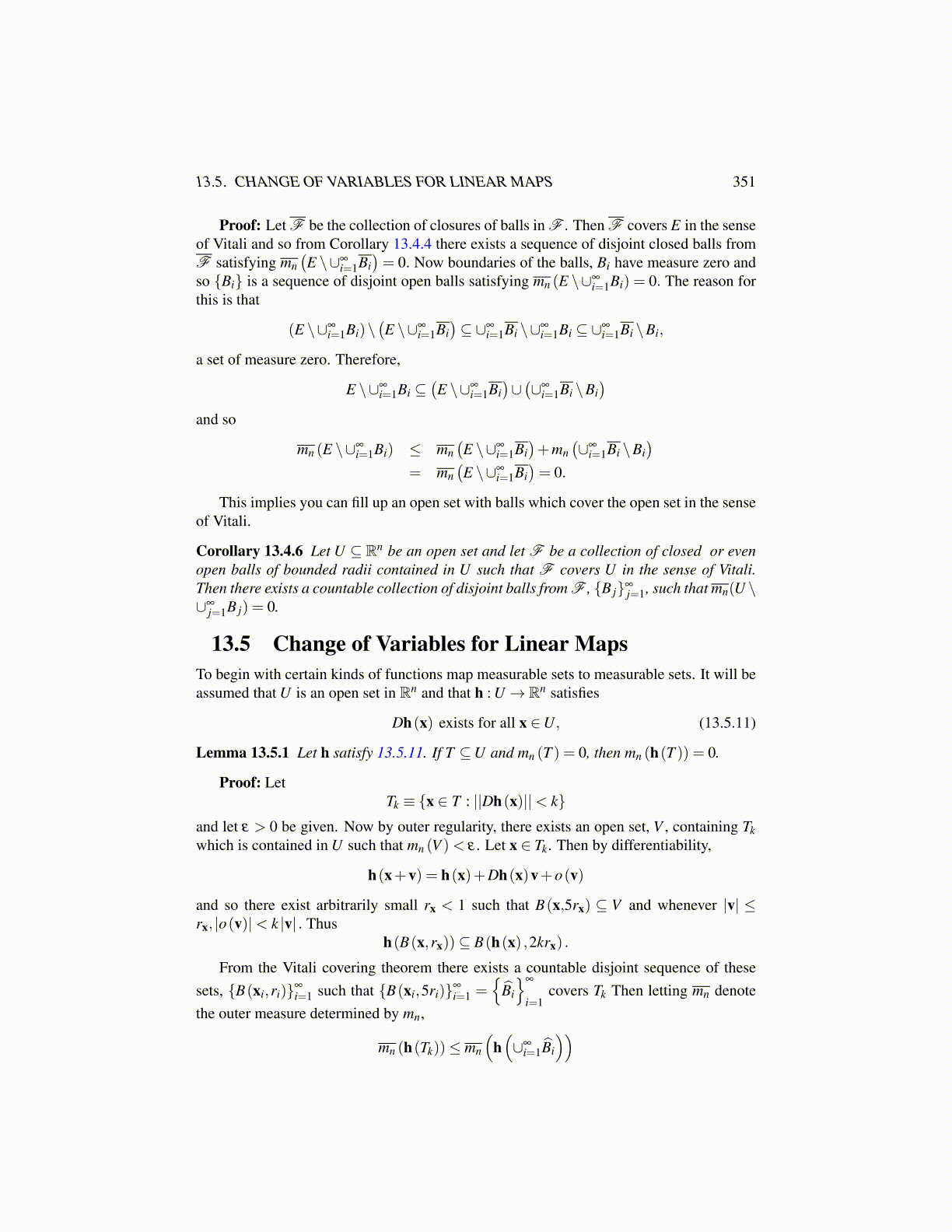
13.5. CHANGE OF VARIABLES FOR LINEAR MAPS 351
Proof: Let F be the collection of closures of balls in F . Then F covers E in the senseof Vitali and so from Corollary 13.4.4 there exists a sequence of disjoint closed balls fromF satisfying mn
(E \∪∞
i=1Bi)= 0. Now boundaries of the balls, Bi have measure zero and
so {Bi} is a sequence of disjoint open balls satisfying mn (E \∪∞i=1Bi) = 0. The reason for
this is that
(E \∪∞i=1Bi)\
(E \∪∞
i=1Bi)⊆ ∪∞
i=1Bi \∪∞i=1Bi ⊆ ∪∞
i=1Bi \Bi,
a set of measure zero. Therefore,
E \∪∞i=1Bi ⊆
(E \∪∞
i=1Bi)∪(∪∞
i=1Bi \Bi)
and so
mn (E \∪∞i=1Bi) ≤ mn
(E \∪∞
i=1Bi)+mn
(∪∞
i=1Bi \Bi)
= mn(E \∪∞
i=1Bi)= 0.
This implies you can fill up an open set with balls which cover the open set in the senseof Vitali.
Corollary 13.4.6 Let U ⊆ Rn be an open set and let F be a collection of closed or evenopen balls of bounded radii contained in U such that F covers U in the sense of Vitali.Then there exists a countable collection of disjoint balls from F , {B j}∞
j=1, such that mn(U \∪∞
j=1B j) = 0.
13.5 Change of Variables for Linear MapsTo begin with certain kinds of functions map measurable sets to measurable sets. It will beassumed that U is an open set in Rn and that h : U → Rn satisfies
Dh(x) exists for all x ∈U, (13.5.11)
Lemma 13.5.1 Let h satisfy 13.5.11. If T ⊆U and mn (T ) = 0, then mn (h(T )) = 0.
Proof: LetTk ≡ {x ∈ T : ||Dh(x)||< k}
and let ε > 0 be given. Now by outer regularity, there exists an open set, V , containing Tkwhich is contained in U such that mn (V )< ε . Let x ∈ Tk. Then by differentiability,
h(x+v) = h(x)+Dh(x)v+o(v)
and so there exist arbitrarily small rx < 1 such that B(x,5rx) ⊆ V and whenever |v| ≤rx, |o(v)|< k |v| . Thus
h(B(x,rx))⊆ B(h(x) ,2krx) .
From the Vitali covering theorem there exists a countable disjoint sequence of thesesets, {B(xi,ri)}∞
i=1 such that {B(xi,5ri)}∞
i=1 ={
B̂i
}∞
i=1covers Tk Then letting mn denote
the outer measure determined by mn,
mn (h(Tk))≤ mn
(h(∪∞
i=1B̂i
))